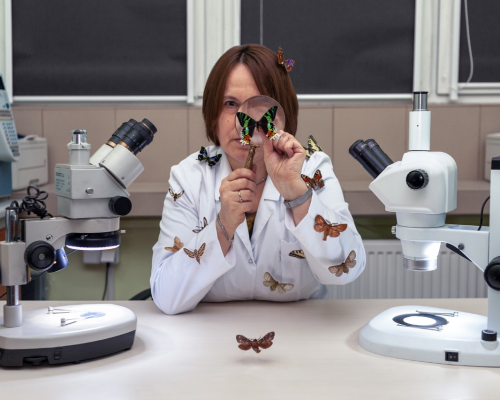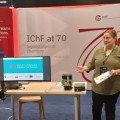Let’s talk to a moth about sex: Polish chemists have 'made a deal' with a butterfly threatening pine forests
Reading time: about 6 minuts

Behind the seven mountains and seven forests hid a hungry beast. Does this sound like a fairy tale? In reality, such a beast does exist. It is the caterpillar of the nocturnal pine-tree lappet moth (Dendrolimus pini, L.), which feed on pine needles, causing severe weakening of trees and, in some cases, their death. On the other hand, words of love between these night butterflies can be the key to preventing outbreaks of destructive munching - in the case of the caterpillars of the said butterfly. Monitoring the population of these pests, and in the future controlling it, is becoming possible thanks to the hard work of a team of scientists from the Institute of Physical Chemistry of the Polish Academy of Sciences (IPC PAS) led by Prof. Rafal Szmigielski in cooperation with the Forest Research Institute. Here they deciphered the chemical hieroglyphics of the language by which female barnacles attract males, finding a way to deal with the voracious beast and save the pine forests. Let's take a closer look at their discovery.
The voracious caterpillars of the pine-tree lappet Dendrolimus pini are capable of significantly weakening and even destroying tens of thousands of hectares of forest. Despite the lack of ecological means to effectively combat this insect, we will not have to say goodbye to pine trees. A path towards effective protection against the lappet moth has been found by scientists from the Institute of Physical Chemistry of the Polish Academy of Sciences (IPC PAS). They have deciphered the chemical "words of love" by which female barnacles attract males. The new preparation based, among other things, on components of the sex pheromone of the voracious insect, developed by scientists from the IPC PAS, may be an effective tool for monitoring and, in the long run, also for controlling the abundance of pine-tree lappet moth in our forests.
The pine-tree lappet moth Dendrolimus pini, a moth with a stocky body and gray-brown coloration, is one of the largest nocturnal butterflies in Poland. After overwintering in the mulch, the caterpillars of this butterfly climb to the crowns of pine trees, where they busily devour the needles. Since up to several hundred perpetually hungry caterpillars can feed on a single tree, the rapid growth of the barnacle population can lead to the weakening of large forest areas. In the absence of ecological and efficient means to control barnacles, information on changes in their population size is crucial. However, traps with synthetic pheromones, used so far by foresters to attract males, have caught relatively few insects. Within the framework of a project carried out by scientists from the IPC PAS in cooperation with the Forest Research Institute (IBL), the development of a new and much more effective components to the sex pheromone of the pine-tree moth has been undertaken Such a preparation could serve not only to monitor, but also in the future - to control the population of these butterflies in a given area.
Research into the chemical love language of the pine barnacle has proved more difficult from the start than scientists had anticipated - and for entirely surprising reasons. The research began with identifying the pheromones' components secreted by young Dendrolimus pini females. In order to develop a preparation to attract courting males, all the chemical compounds that are components of the sexual pheromone were taken under the magnifying glass. Interestingly, in addition to the previously known chemical compounds, the secreted "pheromone perfume" showed the presence of other components, including - compounds derived from the needles of mother trees and previously unknown organic compounds, which significantly affected the behavior of males of this butterfly. The captured mixtures of substances were chromatographically separated into individual components and subjected to detailed chemical analysis using, among other, tandem mass spectrometry. The comparison of the molecular structures of the identified Dendrolimus pini sex pheromone components with the composition of a commercially available product strengthened the researchers' conviction that one of the most important reasons for the pine-tree lappet moths' poor response to the synthetic pheromone was its oversimplified chemical composition and the lack of key bioactive components.
Based on the results of detailed analyses, chemists from the IPC PAS designed new formulations of the pheromone mixtures, which were subjected to numerous tests in a laboratory framework using modern bioanalytical techniques, including - wind tunnel, olfactometry and electroanthenography, and then in cooperation with scientists from the IBL - in field studies. For example, moth males were placed in a wind tunnel by exposing them to certain chemicals or mixtures of chemicals that mimic the odor emitted by females to test the attractiveness of these compounds to male barnacles. The researchers took a closer look at some of the components of the discovered pheromone, such as (Z5)-dodecanal, abbreviated as (Z5)-12:Ald, which increased the attractiveness of the developed composition to attract barnacle butterflies.
"Our goal was to identify all the substances in the pheromones secreted by the moth and create a unique formula that allows us to divert the attention of male barnacle wasps from females. And all this to protect pine forests from the munching of their offspring - barnacle caterpillars," says Prof. Dr. Rafal Szmigielski.
"The mixture of chemical compounds we have identified and patented can - naturally, with appropriate conventionality - be treated as certain words of non-trivial structure, spoken in the chemical language of the barnacles. The main emphasis here is on two 'voiced' words, one of which people pronounce differently from the other. To make this chemical "'I love you" sound convincing, other additional words are needed, increasing the carrying capacity of the main message, i.e. compounds of plant origin," – explains Prof. Dr. Rafal Szmigielski.
Earlier commercially available agents attracted no more than a few dozen pine barnacle males per trap over a period of several weeks. Meanwhile, chemical calling using a mixture of substances developed by a group from the IPC PAS and the IBL increased this number to as many as 160 males per trap in 3-4 days. Such a spike in interest from the insects was unanimously considered by foresters to be a huge success, as it increases the prospects for protecting pine forests from the appetite of the insects' voracious caterpillars.
The identification of new components of the sex pheromone emitted by female Dendrolimus pini moths and their correlation with specific behavior of the male of this butterfly is a step forward toward effective protection of pine forests. The scientists' research into creating synthetic pheromones is also more than just monitoring the moth's behavior. Above all, it is interdisciplinary work and a love of nature and the fascinating micro-world.
This research received funding from the National Center for Research and Development (contract number PBS2/A9/25/2013).
CONTACTS:
dr. inż. Krzysztof Rudziński
Instytut Chemii Fizycznej Polskiej Akademii Nauk w Warszawie
tel.: +48 22 3433402
email: kjrudz@ichf.edu.pl
dr. inż. Monika Asztemborska
Instytut Chemii Fizycznej Polskiej Akademii Nauk w Warszawie
tel.: +48 22 3433402
email: masztemborska@ichf.edu.pl
prof. dr hab. inż. Rafał Szmigielski
Instytut Chemii Fizycznej Polskiej Akademii Nauk w Warszawie
tel.: +48 22 3433402
email: ralf@ichf.edu.pl
SCIENTIFIC PAPERS:
Rudziński KJ, Staszek D, Asztemborska M, Sukovata L, Raczko J, Cieślak M, Kolk A, Szmigielski R.
Newly Discovered Components of Dendrolimus pini Sex Pheromone.
Insects. 2022; 13(11):1063
- Author: Dr Magdalena Osial
- Contact: magdalena@osial.eu
- Photo source: Grzegorz Krzyzewski
- Date: 14.02.2023







